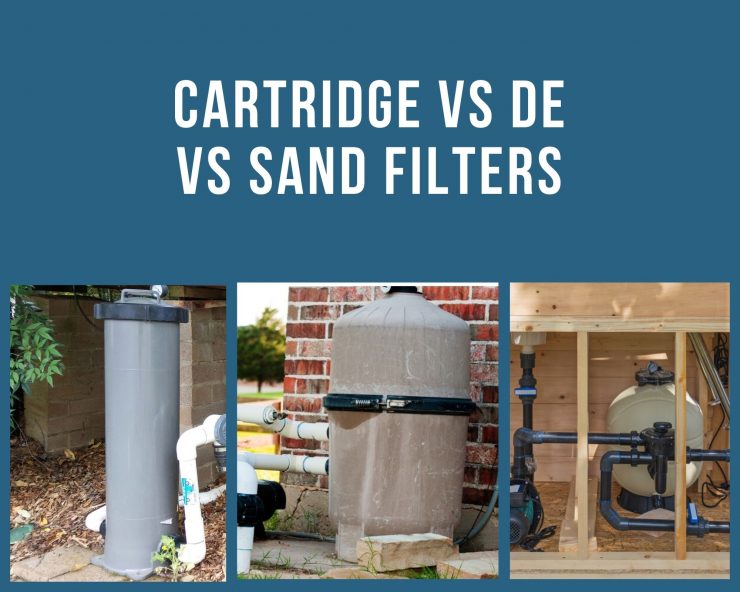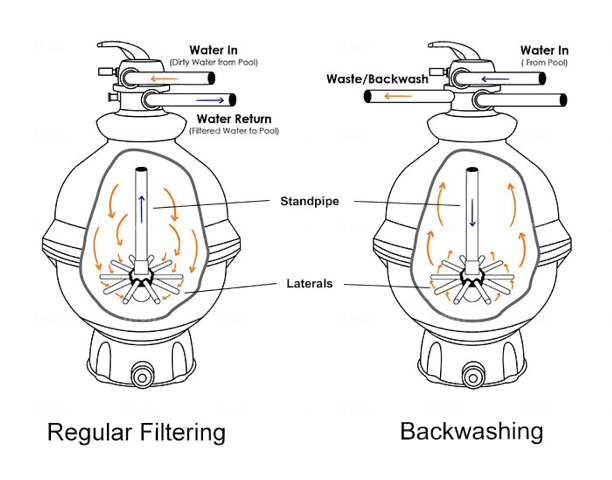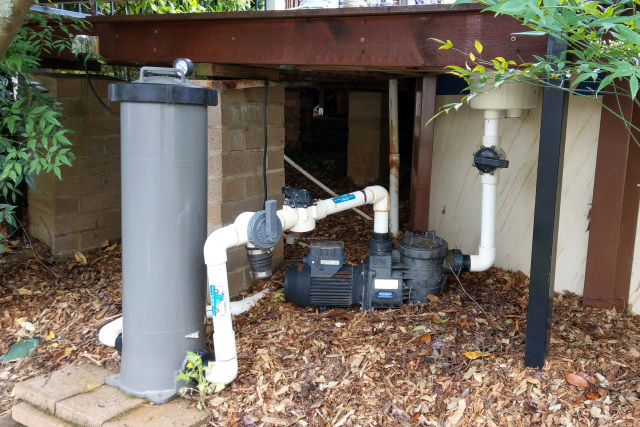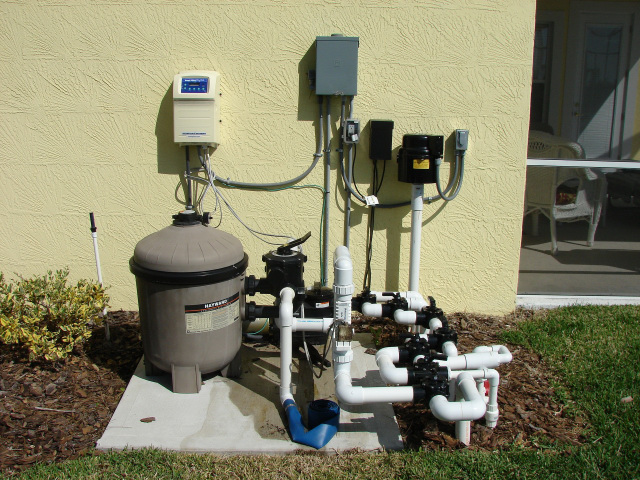Your pool needs a filter for to clean the water, but you had never realized there were so many types of pool filters available. When comparing a sand filter to a cartridge filter and one with diatomaceous earth or DE, which is the best filter?
There’s no one best type of pool filter between sand, cartridge, and DE filters. Sand is easy to use but only filters large particles. Cartridge filters don’t need backwashing but do require frequent cleaning. DE filters remove small particles but need more maintenance still.
Ahead, we’ll talk about each filter in detail, including the pros and cons. By the time you’re done reading, you’ll know the clear differences between sand, cartridge, and DE filters so you can select the best one for your pool!

Article Contents
Sand vs. Cartridge vs. DE Filters – An Overview
Before we can fairly compare one type of filter to another, you need to be clear on each of the three common pool filters. To recap, those are sand, cartridge, and diatomaceous earth or DE filters.
Here’s an overview of each type now.
Sand Filters
Of the three pool filter types, sand filters are the most common. In the filter is No. 20 silica sand which you can find at swimming pool supply stores and at many home improvement stores (as well as online, of course).
As the pool water enters the filter tank, it passes through the sand bed. That sand bed is designed to catch impurities in your pool water. The clean water exits through filter tubes nearer the bottom and then is pumped back out into the pool.
The sand bed will continue catching dirt and debris until it’s full. At that point, the filter’s pressure goes up, which tells you it’s time to backwash.
When you backwash a swimming pool, you send water through the filter in the opposite direction than usual. To backwash the filter, all you need to do is change the valve on your multiport valve to the “backwash” setting from the filter setting.

With a sand filter, backwashing is a regular requirement.
Cartridge Filters
Your next pool filter option is a cartridge filter. The best thing to liken this pool filter to is the air filter in your car or truck. There’s a filter element built into the cartridge filter that the pool water goes through.

When in the filter, the cartridge captures impurities. The filter cartridge itself is cylindrical with a plastic base and pleated fabric on the inside. The fabric is blocks dirt and debris from traveling any further, but allows clean water through.
Every six months or so, you should take the filter cartridge out of your pool filter and wash it down using your gardening hose or even a nearby tap. When the pleated fabric is clean, you can restore the filter and continue using it. There’s no need for backwashing but you may need to soak it in filter cleaner or muriatic acid.
Here’s an article showing you how to clean a cartridge filter.
If the water flow rate of your swimming pool is on the faster side, cartridge filters aren’t as effective. A large pool pump can make them work less efficiently. The bigger pool pump could send water through the filter before it can capture the debris.
That said, the latter issue is not a problem with the cartridge filter itself so much as it is your pool pump of choice.
Diatomaceous Earth Filters (DE Filter)
The third and final type of pool filter is a diatomaceous earth or DE filter. What is diatomaceous earth, you ask? It’s a white, powdery substance that’s sourced from diatom remains. Diatoms are aquatic creatures. Their remains fossilize, and that’s why DE has a trademark whitish color.

The diatomaceous earth is added to the filter grid. When dirty pool water enters the filter grid, it grasps onto particles. The size of diatom remains is smaller and finer compared to sand, which allows a DE filter to capture tinier particles.
The filter element can get dirty over time. You’ll have to take the grid out and then use your garden hose to clean it off. Some pool owners will soak their DE filter grid in water to clear away any traces of minerals, dirt, and oils.
Besides washing down the filter element, you must backwash a DE filter as well.
Pool Filter Comparison Chart
This specs table will pull together all the pertinent information on the three types of pool filters so you can more easily decide which you want.
| Filtering Media | Maintenance | Ongoing Costs | Replacement Costs | Filter Efficiency in Microns | |
| Sand Filter | Sand bed | Backwash at least monthly, if not more often, replace sand about every five years | Sand | $150 to $500 | 20 to 40 microns |
| Cartridge Filter | Filter cartridge (up to 4) | Replace filter every two or three years | Filter cartridges | $120 to $330 | 10 to 20 microns |
| DE Filter | DE filter grid and DE powder. | Backwash every couple of months, add DE in grid after every backwash | Diatomaceous earth, grid filters | $370 to $1,100 | 1 to 6 microns |
Diatomaceous Earth vs. Sand Filter: Which Is Better?
Overall a DE filter will result in a much cleaner pool when compared to a sand filter. Diatomaceous earth filters filter much small particles, approx. 1-6 microns, compared to a sand filter which filters particles that are 20-40 microns in size. A DE filter will however require a lot more maintenance and ongoing costs.
Here’s the full breakdown of which is better.
Let’s start by comparing diatomaceous earth filters and sand filters.
DE filters and sand filters work in a very similar way, in that they both use a powder or sand to catch impurities. Both filters can only handle so much before they require backwashing.
Since they work in similar ways, the advantages that one type of filter has over the other will be due to the filter medium type and its efficiency. That’s why we must talk about the particle sizes that that DE filters can catch.
The finer the particles a pool filter can collect, the cleaner your pool water will be and the more clear the water will be. Sand filters can only entrap particles between 20 and 40 microns. That’s small, don’t get us wrong, but it’s not as microscopically small as the particle fineness of a diatomaceous earth filter.
DE filters can collect particles between 1 and 6 microns. Even the teeny-tiniest bits of dust, dirt, and other debris won’t be able to get through a DE filter. That means a DE filter will give you much clearer water than a sand filter.
Incidentally, some pool owners have had some success and great results adding a small amount of DE to their sand filter. Read more about this here: Can You Put DE in a Sand Filter to Improve Filtration?
Of course, for the filtering excellence of a DE filter, they do require more work and money to maintain than a sand filter. Besides the backwashing requirement, you must also clean the filter grid occasionally using a garden hose. And anytime you backwash the filter, you must add more DE.
Even still, we’re giving this one to DE filters. A cleaner pool is the price you’ll pay for a bit of extra work, and we say the price is worth it!
Diatomaceous Earth vs. Cartridge Filter: Which Is Better?
Diatomaceous earth (DE) filters are better at filtering than cartridge filters. A DE filter will result in clearer pool water than a cartridge filter. A cartridge filter will filter better than a sand filter though. DE filters may have the best filtering ability, but they are more expensive to maintain and require more labor.
Now let’s take the winner from the last round–diatomaceous earth filters–and compare them to the third type of pool filter, which is cartridge filters.
Cartridge filters do have some clear advantages over DE filters. For one, you don’t have to backwash. We want to reiterate that each time you backwash your swimming pool, you remove water from the pool and that means you need to fill it up and then add more chemicals.
You should always test the pool water afterward to see which chemicals have been depleted by backwashing. Then you need to restore those chemicals.
Compared to a sand filter, you’ll backwash a diatomaceous earth filter far less often, every few months rather than every couple of weeks. You still have to backwash though, and that means more time and money put towards maintaining your pool chemistry.
With a cartridge filter, you also don’t have to put as much time and maintenance as you do with a DE filter. Remember, you must add more diatomaceous earth to this filter after every backwash, and it’s not like DE grows on trees. You’ll have to have a steady supply available, which can be costly.
However, cartridge filters don’t filter as well as a DE filter but the cartridge filter will filter better than a sand filter. Many pool owners attest to the awesome filtering abilities of DE filters, which does say something.
Sand Filter Pros and Cons
Next, let’s go through and investigate the pros and cons of all three types of pool filters we’ve discussed in this post, beginning with sand filters.
Pros
- Sand filters have longevity on their side being the most traditional type of pool filter.
- The sand in the filter lasts a long time, anywhere from five to seven years before you need to replace it.
- Sand filters are typically the least expensive of the three pool filters.
- They are very easy to maintain. Backwashing is quick and easy.
Cons
- Sand filters require regular backwashing every few weeks, which will likely affect the balance of your swimming pool.
- When backwashing, you must have a place to redirect the dirty water.
- Sand filters will capture particles at 20 microns, so very small particles can easily travel through the sand bed and back into your pool – meaning cloudier water.
DE Filter Pros and Cons
Next, let’s highlight diatomaceous earth filters with a pros and cons list.
Pros
- DE filters can capture particles between 2 and 3 microns, which is far better than a sand filter can do.
- Your pool pump might not have to run as much if your pool is cleaner thanks to a DE filter.
- Provide the best filtering and clearest water out of any filter.
- You don’t have to backwash a DE filter too often, usually every couple of months.
Cons
- You still must backwash a DE filter, which means it’s possible you’ll disrupt the pool chemistry.
- Every time you backwash, you must add more diatomaceous earth to the filter.
- You also must clean the filter element using a gardening hose from time to time. This all adds up to DE filters requiring the most maintenance and ongoing cost.
- Diatomaceous earth is a known carcinogen.
Cartridge Filter Pros and Cons
Lastly, let’s talk about the pros and cons of cartridge pool filters.
Pros
- You don’t need to use a multiport valve with a cartridge filter.
- Filter better than sand filters resulting in clearer water.
- You can also avoid backwashing with a cartridge filter, which helps you maintain your pool chemistry for longer.
- The average lifespan of a filter cartridge is three years.
Cons
- For faster-flowing pools, the water can travel through a cartridge filter so fast that the filter doesn’t even work.
- You’ll have to clean a cartridge filter regularly. It can be time consuming to do.
- Replacing filter cartridges can be costly in some cases – especially if your filter uses multiple cartridges.
Can You Switch From One Type of Filter to Another?
What if you want to go from a cartridge filter to a sand filter or a sand filter to a diatomaceous earth filter? Can you switch between them as desired?
Yes you can if you are willing to adjust the plumbing and possibly upgrade your pump. Even though pool filters and DE filters work similarly, there are enough differences between these two filter types that you cannot use them interchangeably. Cartridge filters don’t really slot in that easily either.
Unfortunately, it’s not a simple DIY job like taking out the cartridges and adding sand in. Or taking out the DE and adding sand.
If you want to change the filter you use, you’ll need to buy a new filter, upgrade your pool pump and change the plumbing around, then you can switch pool filter types.
Pro filter hack: Adding a small amount, about ½ to 1 cup of DE to a sand filter after backwashing can work wonders. Do this can greatly improve your sand filter’s filtering ability. But don’t add too much.
Conclusion
When selecting a pool filter, your options are sand filters, cartridge filters, and diatomaceous earth or DE filters. Each has its advantages, which this post illustrated. Now you’re ready to buy the right type of filter for a cleaner, brighter pool!
Related Reading:
How to Raise Alkalinity in Hot Tub (Alkalinity is Low)
How to Choose the Best Pool Pump for an Intex Pool

